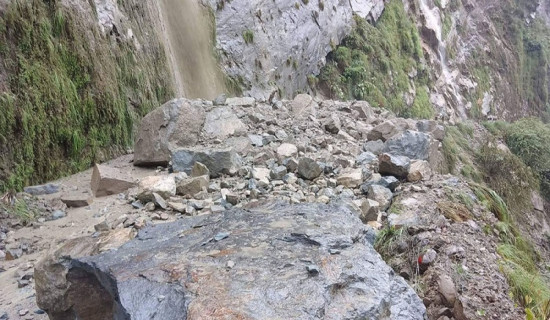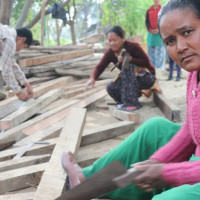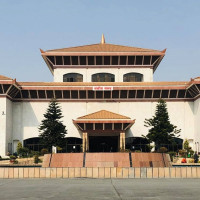- Thursday, 19 June 2025
Irrigation far from enough to make nation self-reliant in food grains
By Laxman Kafle,Kathmandu, June 18: Agriculture has been main occupation of Nepali people and the backbone of the national economy. However, the sad fact is that still majority of farmers in Nepal depend on monsoon rains to grow food grains as the country has fared badly in providing irrigation facilities to them.
Although there is no dearth of water resources across the country, in lack of insufficient irrigation infrastructures, farmers having their paddy fields just above the mighty rivers have to look at the sky during paddy planation season because still only 14 per cent of the arable land in Nepal has irrigation facilities round the year. Various studies have shown that irrigation has a 30 to 60 per cent role in agricultural production, and the development of agriculture plays a significant role in increasing agricultural production and productivity. However, the investment in irrigation sector has been minimal.
History of developing irrigation facilities in Nepal goes back to 1822 when the construction of Chandra Nahar (canal) began in Saptari during the time of Rana Prime Minister Chandra Shumsher Rana. The canal construction completed in six years and water distribution began in 1828.
The development of modern irrigation facility began from the government in the early 1950s and since then, the government has been running small and large irrigation and river management projects on its own investment and with the assistance of various national and international organisations.
According to the Department of Water Resources and Irrigation under the Ministry of Energy, Water Resources and Irrigation, only 60 per cent of the total irrigable land in Nepal is now irrigated. This means that the majority of the farmers rely on rainfall to grow crops. They are often vulnerable to droughts and other weather-related risks.
According to Deputy Director General of Department of Water Resources and Irrigation Rukmangat Khanal, infrastructure has been developed to provide irrigation facilities to 1.535 million hectares of total 2.54 million hectares of irrigable farmland.
Of the total 3.557 million hectares of arable land, only 2.536 million hectares of land is suitable for irrigation.
As per the statistics, only 32 per cent (500,000 hectare) of the total irrigable land and 14 per cent of the total arable land is irrigated round the year.
He said that most of the irrigation projects were built on the run-of-the-river nature systems, which could not be adequately maintained and the natural springs and water sources were drying up, so reliable irrigation services could not be provided throughout the year.
According to the Department, 66.46 per cent of the irrigated area is served by surface irrigation system (including lift irrigation) and 33.54 per cent of the area is served by underground irrigation system (including new irrigation technology).
Mega irrigation projects
For sustainable irrigation facilities and high agricultural yield, the government has forwarded construction of various mega and national pride projects, Khanal said. Various projects of national pride, such as Sikta Irrigation Project, Sunkoshi Marin Diversion Multipurpose Project, Mahakali Irrigation Project, Rani Jamara Kulariya Irrigation Project, Babai Irrigation Project and Bheri-Babai Diversion Multipurpose Project are being implemented or are in various stages of construction. Construction of Sikta began in 2005-06 and that of Rani Jamara Kulariya Irrigation Project in 2009/10.
Similarly, the construction of Bheri-Babai Diversion Multipurpose Project started in 2011/12, Mahakali in 2006/07 and Sunkoshi Marin Diversion Multipurpose Project in 2016/17.
Physical and financial progress of these projects has been significant, he said. However, various problems such as lack of funds, unofficial Indian blockade, earthquake and the COVID-19 pandemic have delayed completion of many of these projects.
Sikta Irrigation Project built by constructing a barrage in the Rapti River in Banke district that provides irrigation facilities to 42,766 hectares of land is still under construction while Rani the construction of the Jamara Kulariya Irrigation Project that can provide irrigation facilities to 38,300 hectares of land in Kailali district has reached its final stage.
The Rani Jamara Kulariya Irrigation Project is now providing irrigation facilities to 11,000 hectares of land in Tikapur Municipality, Lamki Chuha Municipality and Janaki Rural Municipality of Kailali district.
Similarly, Babai Irrigation Project that can irrigate 36,000 hectares of land in Bardiya district and the Bheri-Babai Diversion Multipurpose Project that
can provide irrigation facilities throughout the year to 51,000 hectares of land in Banke and additional 15,000 ha in Bardiya districts are under construction.
The Sunsari Morang Irrigation Project is also under construction. It will provide irrigation facilities to about 68,000 hectares of land in Morang and Sunsari districts.
Likewise, Bagmati Irrigation Project (including Sunkoshi Marin Diversion) that will provide irrigation facilities to 122,000 hectares of land in Sarlahi, Rautahat, Bara, Dhanusha and Mahottari districts in Madhes and Mahakali Irrigation Project (Phase III) to irrigate 33,520 hectares of land in Kailali and Kanchanpur districts are also under construction.
Besides, the federal government has been forwarding other mega irrigation projects while the provincial and local governments are also constructing small and medium size irrigation projects.
Inadequate budget
Despite the governments' efforts, progress in improving the status of irrigation in the country has been slow. Inadequate funding, lack of new technologies, poor coordination between government agencies and political instability are blamed for this.
The government has been allocating around Rs. 20-25 billion for irrigation in its annual budget every year but that has not been enough to expand the irrigation infrastructures as needed, Khanal said.
"At least around Rs. 50 billion is required annually for the completion of ongoing projects and launch other irrigation schemes," he said.
He also stressed the need for investing in deep boring, shallow tubewell and lift irrigation based on geographical situation. According to him, the Department has been developing the irrigation infrastructures by utilising the allocated budget.
Irrigation facility is expected to reach an additional 15,000 hectares of land by the end of the current fiscal year. It had reached additional 21,642 hectares of land in the last fiscal year 2021/22 and 27,129 hectares in the fiscal year 2020/21.
The new budget for the next fiscal year has emphasised the construction of large, multipurpose projects with reservoirs and waterways and set a goal of expanding irrigation services to 18,400 hectares of land through the irrigation projects to be implemented in the fiscal year 2023/24.
Director General of the Department of Agriculture under the Ministry of Agriculture and Livestock Development Dr. Hari Bahadur K.C. said it was a must to forward the construction of small and medium size projects in the pocket areas to ensure irrigation facilities.
The small and medium size irrigation projects are being constructed by the provincial and local governments, he said, however the provincial and local governments are unable to forward the construction of small projects in time.
Problems of agriculture K.C. admitted lack of irrigation facility as a big problem of agriculture sector.
Irrigation is the basic need for agriculture. But, farmers are dependent on rain water for agriculture in the absence of irrigation facilities. Due to this, production goes up if the monsoon is favourable and dips down in case of a drought, he said.
Ram Sharan Dahal, a farmer of Panchkhal-3, Kavre, said that the farmers of Panchkhal, which is famous for agricultural production, especially vegetable cultivation, face the problem of irrigation facilities every year as they depend on rains for farming.
“Panchkhal does not have sustainable irrigation facilities, farmers here depend on rains to grow any crop every year. They are using irrigation by making temporary dams in local rivers. When it rains, water flows in the river and when there is a drought, there is no water in the river," he said."Due to drought, we are not able to keep paddy seeds in time this year," Dahal said.
Climate change impact on irrigation, agriculture
The climate change has affected the rain-dependent agriculture system and production in Nepal over the years, Dahal said, adding that the long spell of drought seen frequently in the country has affected farmers adversely.
"Recently, farmers are unable to keep paddy seeds due to drought. In this situation, farmers cannot plant paddy in time which will affect production. If there is availability of irrigation facility, farmers can keep paddy seeds and finish paddy plantation in time," he said.
Due to long spell of drought in May and June, the maize crops and other vegetable farms across the country have been damaged.
Nepal Agriculture Research Council (NARC) has asked the farmers to adopt the farming system keeping in mind that there will be less rain this year.
According to the seasonal agriculture information released by the NARC and Weather Forecasting Division, this year's monsoon season may receive 35 to 55 per cent less rain than the average.
Irrigation must to make country self-reliant in cereals Dr. K.C. said that there is no chance to make the country self-reliant especially in cereal crops in the absence of irrigation.
"Definitely, advanced and hybrid seeds are equally important for increased production and productivity. But, the production will not increase only by using hybrid seeds if there is no proper irrigation facility," he said.
The Tarai is known as the breadbasket, he said, adding that it is essential to ensure access to irrigation facilities in the entire swathe of land to make the country self-reliant in food.
The deep boring and shallow tube well irrigation projects are being developed in Tarai. The government has been providing electricity to the farmers at subsidised rates for irrigation.
He stressed the need for using modern technologies for irrigation rather than traditional systems such as embankment in local rivers.
Deputy Director Khanal said that the Department had carried out various programmes in the Tarai to ensure irrigation facilities. Out of 2.536 million hectares of irrigable land, around 1.49 million hectares are in Tarai.
He expressed his hope that the irrigation facilities, especially in the Tarai region, would be improved and supply water round the year after the completion of the ongoing national pride projects.
He said that if we ensure irrigation facilities round the year in cultivable land, it will contribute to an increase of at least 33 per cent to productivity. Per hectare productivity of paddy stands at five tonnes in the place where irrigation facilities have reached.
Dr. Prem Prasad Dangal, chairman of National Farmers' Commission, said that the farmers have been facing with huge losses frequently due to drought as most of the farms are dependent on rains.
The local levels are responsible to construct small irrigation projects to ensure the access of irrigation facilities with the aim of optimum use of land. But the local levels are not paying any interest to construct small irrigation structures, preserve traditional canals, wetland and other agricultural activities for the increase of agriculture products.
"The time has come to do agriculture with the use of less water due to climate change. So, the government should introduce climate-friendly agricultural tools for increasing agricultural produce," he said.
















